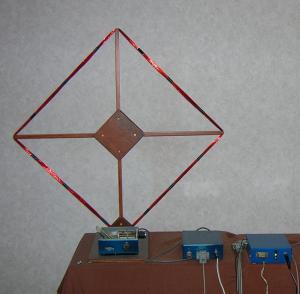2020 March 15
Introduction to VLF observations of solar activity
Observing and recording the visual appearance of the sun’s photosphere is a favourite activity for amateur astronomers, and requires a minimum of equipment. Hydrogen alpha observations of prominences and filaments is also a popular activity, showing some of the dynamic activity present around active areas on the sun.

The D-region of the ionosphere, at an altitude of about 70..80km, is created directly by solar radiation. Normal levels of daytime solar radiation ionise the D-region such that radio waves in the VLF spectrum (15..30kHz) can be efficiently propagated over large distances. At night, the lack of solar radiation allows the D-region to re-combine. VLF propagation then becomes less predictable. The sudden increase in ionising UV and X-rays from a solar flare during the daytime produces a rapid increase in D-region ionisation, so that VLF propagation is disturbed.
VLF monitoring of solar flares relies on reception of a remote radio transmitter. Its received signal strength depends partly on the effectiveness of the D-region, and is therefore affected directly by the solar flare. D-region ionisation levels vary smoothly through the day with the changing altitude of the sun (see Figure 2) and will be much the same from one day to the next. The changing seasons are clearly seen as the day length and solar altitude changes. Nighttime reception will be random due to the absence of solar radiation, and cannot therefore be used to monitor solar activity.

When a solar flare occurs during the daytime however, the received signal strength will rapidly change in a characteristic manner, before decaying back to its pre-flare level. This Sudden Ionospheric Disturbance can be timed, and used to indicate the occurrence of a solar flare. The actual shape of the SID recorded will vary with the strength of the flare as well as the distance to the transmitter being monitored (see Figure 3).

All radio waves propagate by multiple paths. The direct signal (ground wave) follows the line of sight from transmitter to receiver, while the sky wave is the part that is reflected / refracted by the D-region. The signal strength at the receiver is the sum of these two parts, an effect often noted as ‘multipath distortion’ at VHF. The two paths have different lengths, and so they have a varying phase difference at the receiver leading to enhancement or partial cancellation of the signal. D-region disturbance from a flare will alter the path length of the sky wave, and therefore alter the interference pattern produced at the receiver. This moving interference pattern can cause a SID to increase or decrease in signal strength as shown by the two signals in figure 3, and also produce more complex multiple peak/dip effects.
There are several suitable transmitters in Europe that can be used for this work:-
18.3kHz Central France.
19.6kHz Anthorn, UK
20.3kHz Isola di Tavolara, Italy.
22.1kHz Skelton, UK.
23.4kHz Ramsloh, Germany.
There also some more remote transmitters:-
24.0kHz Maine, USA
37.5kHz Keflavik, Iceland.
Good results can be obtained with any of these signals, although some may be easier to find amongst local radio interference. They all have periods when they are switched off, and so 100% coverage cannot be obtained from a single receiver. A receiver can be re-tuned as necessary, a process requiring a little skill and experience as well as some test equipment. Receivers are available ready built and tuned, along with the loop aerial shown in Figure 1. An alternative to a fixed frequency receiver is to use software such as Spectrum Lab on a PC. This uses the sound card with an aerial plugged directly into the microphone socket. The software is then configured to record the required frequencies and save the data to disc every day. Either method can produce excellent results. The use of Spectrum Lab is also recommended to check for local interference and pick the best signals. Recordings and observations sent to the director are used in a monthly summary available on request.
John Cook
Radio Astronomy Section Director.
| The British Astronomical Association supports amateur astronomers around the UK and the rest of the world. Find out more about the BAA or join us. |
